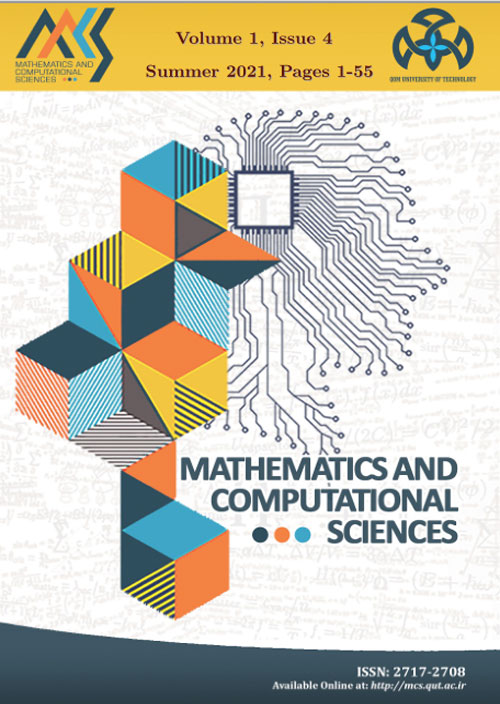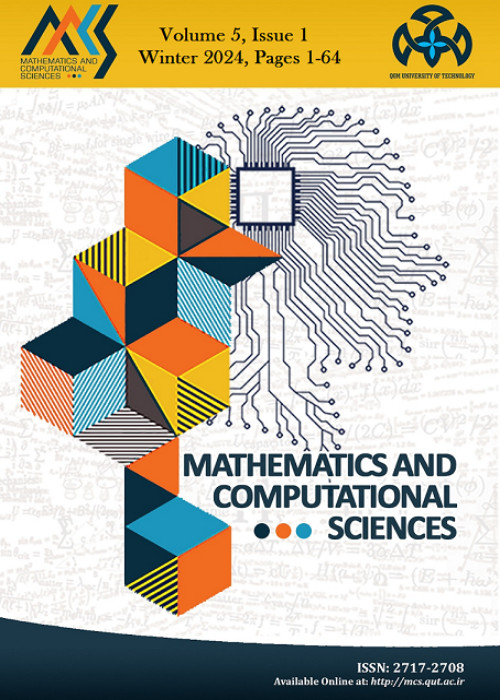فهرست مطالب

Mathematics and Computational Sciences
Volume:2 Issue: 3, Summer 2021
- تاریخ انتشار: 1400/06/27
- تعداد عناوین: 6
-
-
Pages 1-13In this study, a mathematical model to examine the combined effects of nanoparticles of Copper (Cu) and Alumina ( Al 2 O 3) in unsteady channel flow of water (river) based nanofluids was established. Both first and second laws of thermodynamics were employed to analyze the model. Using the discretization finite difference method together with the Runge-Kutta integration scheme, the governing partial differential equations were solved numerically. Numerical simulations on the effects of parameter variation on concentration and temperature were graphically presented and quantitatively discussed. Results show that the nanofluid concentration increases with an increase in thermophoresis parameter (Nt) and nanoparticle volume fraction (η ) and decreases with the increase in the Biot number (Bi). While nanofluid temperature increases with Biot number (Bi), Schmidt number (Sc) and the Brownian motion parameter (Nb), and decreases with an increased nanoparticle volume fraction (η ). From the study, it was recommended that in cooling systems and industrial processes nanofluids were found significant to be used for the effective operation of machines and cooling systems. Using the same geometry of the channel flow and the same problem, the Brownian motion in any fluid system has a great impact also.Keywords: Modeling, Flow, aquatic, copper, Alumina
-
Pages 14-21
IIn this paper, we prove the Mittag-Leffler-Hyers-Ulam-Rassias stability for cubic functional equation by using the fixed point alternative theorem. As a consequence, we show that the cubic multipliers are superstable under some conditions.
Keywords: Quadratic functional, superstable, cubic multipliers -
Pages 22-26In this paper , we study the concept of the c-nilpotent multiplier of a pair of groups and prove that the c-nilpotent multipliers of perfect pairs of groups are isomorphic .Also, we prove an inequality for the order of the Schur multiplier of a pair of groupsKeywords: Pair of groups, c-nilpotent multiplier, covering pair, perfect group
-
Pages 27-32We consider a two-qubit superconducting system. By introducing the two measures of Concurrence and discord, we calculate the value of the correlations of this system and also determine the changes of the correlations of this system with respect to the temperature and the coupling of the circuits.Keywords: Superconducting system, Concurrence, discord, Quantum correlation
-
Pages 33-42In many applications, one encounters the problem of approximating 1-D curve and 2-D surfaces from data given on a set of scattered points. Meshless methods strategy is based on some facts: (1) deleting mesh generation and re-meshing, (2) raising smooth degree of solution, (3) localization by using compact support weights. This research presented three generalizations for ancient pseudo interpolation, localization, appending a complete polynomial to the Shepard average weighted approximation and Hermite form of Shepard and MLS method. The new bases for relevant space of approximants are developed and, when evaluated directly, improves the accuracy of evaluation of the fitted method, especially the Hermite type. In this work, we develop some efficient schemes for computing global or local approximation curves and surfaces interpolating a given smooth data. Then we raise the smooth degree of approximation and use of derivatives data. The Hermite Shepard (HSH) is straightforward and efficient.Keywords: Local, global interpolation, Weighted least square, Singular weights, Local, global support, Hermite Shepard method
-
Pages 43-55In real-world decision-making problems, we often face multiple criteria that should be considered in the decision process. Also, the collected data are often non-crisp and reported with a degree of hesitation. In this study, using intuitionistic fuzzy numbers that can model these non-crisp and hesitant data, we propose a simple yet effective method for solving real-world multi-criteria decision-making problems. We applied our proposed approach to the intuitionistic fuzzy Best-Worst Method, which is one of the famous techniques for solving multi-criteria decision-making problems. However, the proposed method can be easily generalized to the other multi-criteria decision-making methods in intuitionistic fuzzy environments, too. Finally, the ability of the proposed approach to solve these types of problems is shown by an illustrative example.Keywords: Intuitionistic fuzzy numbers, Multi-criteria decision making, Best-Worst method, Hesitation degree, Decision level


